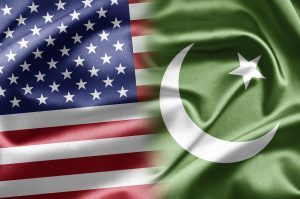Pakistan’s stock exchange plunged sharply on Monday after U.S. President Donald Trump imposed new sweeping tariffs on global trading partners, including Pakistan. The market fell more than 5 percent, forcing an hour-long trade halt.
While Trump’s new string of “Liberation Day” tariffs has sent jitters through the business community in Pakistan, there are hopes that the development could also create new business opportunities for the country.
Washington has imposed a 29 percent reciprocal tariff on imports from Pakistan. This decision appears to be driven by the U.S. desire to bridge the $2.9 billion trade deficit with Pakistan.
For Pakistan, the U.S. is one of the few markets globally where the country maintains a significant trade surplus. In recent years, Pakistan’s textile and apparel exports to the U.S. market have surged.
Despite the newly imposed tariffs, Pakistan’s traditional exports to the U.S. are expected to maintain their trajectory for several reasons. The primary reason is that the tariffs imposed on Pakistan are lower than those on its direct competitors like Bangladesh, Vietnam and China. Although other countries, such as India and Turkey, may face lower tariffs than Pakistan, Islamabad is still likely to benefit due to its significantly lower “per unit price tag” advantage over its direct competitors.
Pakistan has enjoyed this lower price tag advantage for its products for years. However, the country has not been able to translate this advantage into a larger market share in the U.S. This lower price tag advantage could potentially shield Pakistan during this challenging time and help counterbalance the 3 percent advantage that its competitor, India, may have gained.
Moreover, Bangladesh and Vietnam, two major garment suppliers to the U.S. market, are facing steep reciprocal tariffs of 39 percent and 46 percent, respectively. This means Pakistan could still gain a broader market share and be competitive in the U.S., even with its own 29 percent additional tariff.
Furthermore, reports of a potential recession triggered by the escalating U.S.-China trade war suggest that Pakistan may emerge as an unexpected beneficiary. Trump’s aggressive tariff hikes on China — with threats of more — could dramatically inflate the price of Chinese garments and apparel in the U.S.
Notably, Chinese garments are already pricier than Pakistan’s in the U.S. market. With the latest tariff round, and possible future hikes, Pakistan’s products may become more attractive due to lower prices. This could lead to increased orders from U.S. buyers, renewed demand for competitively priced Pakistani goods as well as an expanded market share in the U.S.
The business sector in Pakistan has echoed the sentiment that the tariff situation has unexpectedly given Pakistan a window to strengthen trade ties with the United States. According to a report by the Karachi Chamber of Commerce and Industry (KCCI), higher tariffs on Vietnam and Bangladesh have created opportunities for Pakistan to increase its “market share in textiles, food products and plastics.”
Similarly, Zubair Motiwala, a textile manufacturer and former chief executive at the Trade Development Authority of Pakistan (TDAP) said that “Pakistan’s textile exports will increase to its single largest destination of the U.S. in the wake of Trump’s imposition of reciprocal tariff on imports from majority economies across the world including Pakistan.” “The chances are that Pakistan will receive new textile export orders, as US buyers will cut their imports from those countries that received higher Trump tariffs, and divert their import orders to cheaper countries like Pakistan,” he said.
Pakistan appears to recognize the need for a strategic approach to navigate this situation and capitalize on emerging opportunities. Finance Minister Muhammad Aurangzeb has announced that Pakistan will send a high-powered delegation to the U.S. to discuss the imposition of reciprocal tariffs on Pakistani goods.
“You should never let a good crisis go to waste. We are looking at it both as a challenge as well as an opportunity,” he told reporters in Islamabad.
It seems that Pakistan and the U.S. are exploring new opportunities to expand trade cooperation under the Trump administration, with critical minerals potentially emerging as a key area of collaboration. U.S. Secretary of State Marco Rubio spoke to Pakistani Foreign Minister Ishaq Dar on Monday to discuss newly imposed tariffs, trade relations, and prospects for engagement on critical minerals, the State Department said.
“They [Rubio and Dar] discussed U.S. reciprocal tariffs on Pakistan and how to make progress toward a fair and balanced trade relationship,” the statement read.
“The Secretary raised prospects for engagement on critical minerals and expressed interest in expanding commercial opportunities for U.S. companies [in Pakistan].”
However, traders in Pakistan warn that to make full use of this opportunity, the government needs to help exporters. There are concerns that Pakistan’s heavy reliance on textile exports means its limited product offerings for the U.S. market are susceptible to changing market dynamics. Textiles account for 77 percent of Pakistan’s total exports to the U.S. The government needs to support other sectors exporting leather, surgical goods, cement, and steel products.
Moreover, there is a need to reduce the cost of business for Pakistani companies by reducing energy costs and negotiating tariffs. Amid Trump’s tariffs, the Pakistani government has significantly reduced energy costs for commercial users and promised to do more in the coming weeks. The move has been welcomed by the business community that seeks further actions from the government to help them prepare better for their negotiations with the U.S. buyers.
With unexpected trade disruptions looming, Pakistan’s policymakers must focus on supporting exporters through improved trade relations with the U.S. and new incentives, including potential collaborations in critical minerals. The coming weeks will reveal whether Pakistan can capitalize on its slight tariff advantages over regional competitors.

































